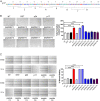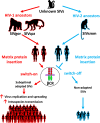Evolution toward beta common chain receptor usage links the matrix proteins of HIV-1 and its ancestors to human erythropoietin
- PMID: 33372148
- PMCID: PMC7812818
- DOI: 10.1073/pnas.2021366118
Evolution toward beta common chain receptor usage links the matrix proteins of HIV-1 and its ancestors to human erythropoietin
Abstract
The HIV-1 matrix protein p17 (p17) is a pleiotropic molecule impacting on different cell types. Its interaction with many cellular proteins underlines the importance of the viral protein as a major determinant of human specific adaptation. We previously showed the proangiogenic capability of p17. Here, by integrating functional analysis and receptor binding, we identify a functional epitope that displays molecular mimicry with human erythropoietin (EPO) and promotes angiogenesis through common beta chain receptor (βCR) activation. The functional EPO-like epitope was found to be present in the matrix protein of HIV-1 ancestors SIV originated in chimpanzees (SIVcpz) and gorillas (SIVgor) but not in that of HIV-2 and its ancestor SIVsmm from sooty mangabeys. According to biological data, evolution of the EPO-like epitope showed a clear differentiation between HIV-1/SIVcpz-gor and HIV-2/SIVsmm branches, thus highlighting this epitope on p17 as a divergent signature discriminating HIV-1 and HIV-2 ancestors. P17 is known to enhance HIV-1 replication. Similarly to other βCR ligands, p17 is capable of attracting and activating HIV-1 target cells and promoting a proinflammatory microenvironment. Thus, it is tempting to speculate that acquisition of an epitope on the matrix proteins of HIV-1 ancestors capable of triggering βCR may have represented a critical step to enhance viral aggressiveness and early human-to-human SIVcpz/gor dissemination. The hypothesis that the p17/βCR interaction and βCR abnormal stimulation may also play a role in sustaining chronic activation and inflammation, thus marking the difference between HIV-1 and HIV-2 in term of pathogenicity, needs further investigation.
Keywords: HIV-1 and HIV-2 ancestors; HIV-1 evolutionary trajectory; HIV-1 matrix protein p17; common beta chain receptor; human erythropoietin.
Copyright © 2021 the Author(s). Published by PNAS.
Conflict of interest statement
Competing interest statement: F.C. and A.C. are listed as inventors in a patent application related to this study.
Figures





Similar articles
-
Simian immunodeficiency virus and human immunodeficiency virus type 1 matrix proteins specify different capabilities to modulate B cell growth.J Virol. 2014 May;88(10):5706-17. doi: 10.1128/JVI.03142-13. Epub 2014 Mar 12. J Virol. 2014. PMID: 24623414 Free PMC article.
-
Fine epitope specificity of anti-erythropoietin antibodies reveals molecular mimicry with HIV-1 p17 protein: a pathogenetic mechanism for HIV-1-related anemia.J Infect Dis. 2011 Sep 15;204(6):902-11. doi: 10.1093/infdis/jir433. J Infect Dis. 2011. PMID: 21849287
-
Role of Autophagy in HIV-1 Matrix Protein p17-Driven Lymphangiogenesis.J Virol. 2017 Jul 27;91(16):e00801-17. doi: 10.1128/JVI.00801-17. Print 2017 Aug 15. J Virol. 2017. PMID: 28592537 Free PMC article.
-
HIV-1 Matrix Protein p17 and its Receptors.Curr Drug Targets. 2016;17(1):23-32. doi: 10.2174/1389450116666150825110840. Curr Drug Targets. 2016. PMID: 26302809 Review.
-
HIV-1 matrix protein p17: a candidate antigen for therapeutic vaccines against AIDS.Pharmacol Ther. 2010 Dec;128(3):433-44. doi: 10.1016/j.pharmthera.2010.08.005. Epub 2010 Sep 8. Pharmacol Ther. 2010. PMID: 20816696 Review.
Cited by
-
The HIV-1 Gag Protein Displays Extensive Functional and Structural Roles in Virus Replication and Infectivity.Int J Mol Sci. 2022 Jul 8;23(14):7569. doi: 10.3390/ijms23147569. Int J Mol Sci. 2022. PMID: 35886917 Free PMC article. Review.
-
The HIV-1 Matrix Protein p17 Does Cross the Blood-Brain Barrier.J Virol. 2022 Jan 12;96(1):e0120021. doi: 10.1128/JVI.01200-21. Epub 2021 Oct 20. J Virol. 2022. PMID: 34668776 Free PMC article.
-
HIV-1 mutants expressing B cell clonogenic matrix protein p17 variants are increasing their prevalence worldwide.Proc Natl Acad Sci U S A. 2022 Jul 5;119(27):e2122050119. doi: 10.1073/pnas.2122050119. Epub 2022 Jun 28. Proc Natl Acad Sci U S A. 2022. PMID: 35763571 Free PMC article.
References
Publication types
MeSH terms
Substances
LinkOut - more resources
Full Text Sources
Other Literature Sources
Research Materials

